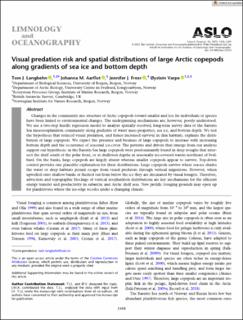Visual predation risk and spatial distributions of large Arctic copepods along gradients of sea ice and bottom depth
Peer reviewed, Journal article
Published version
Permanent lenke
https://hdl.handle.net/11250/3083214Utgivelsesdato
2023Metadata
Vis full innførselSamlinger
- Articles [3012]
- Publikasjoner fra CRIStin [3070]
Sammendrag
Changes in the community size structure of Arctic copepods toward smaller and less fat individuals or species have been linked to environmental changes. The underpinning mechanisms are, however, poorly understood. We use a two-step hurdle regression model to analyze spatially resolved, long-term survey data of the Barents Sea mesozooplankton community along gradients of water mass properties, sea ice, and bottom depth. We test the hypothesis that reduced visual predation, and hence increased survival in dim habitats, explains the distribution of large copepods. We expect the presence and biomass of large copepods to increase with increasing bottom depth and the occurrence of seasonal ice-cover. The patterns and drivers that emerge from our analysis support our hypothesis: in the Barents Sea large copepods were predominantly found in deep troughs that intersect the shelf south of the polar front, or at shallower depths in seasonally ice-covered waters northeast of Svalbard. On the banks, large copepods are largely absent whereas smaller copepods appear to survive. Top-down control provides one plausible explanation for these distributions. Large copepods survive where sea-ice shades the water or deep habitats permit escape from visual predators through vertical migrations. However, when upwelled onto shallow banks or flushed out from below the ice they are decimated by visual foragers. Therefore, advection and topographic blockage of vertical zooplankton distributions are key mechanisms for the efficient energy transfer and productivity in subarctic and Arctic shelf seas. New prolific foraging grounds may open up for planktivores where the ice-edge recedes under a changing climate.
